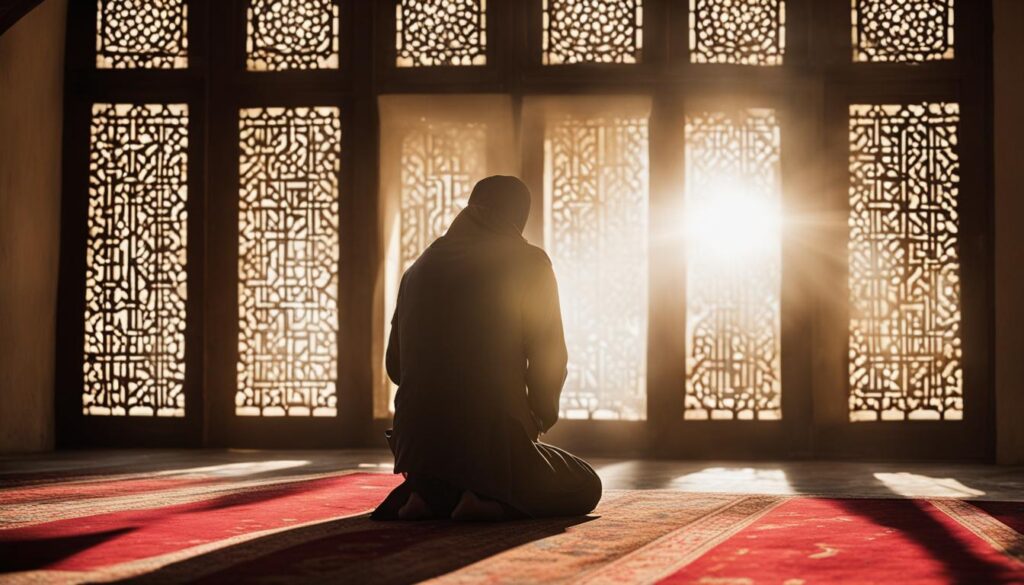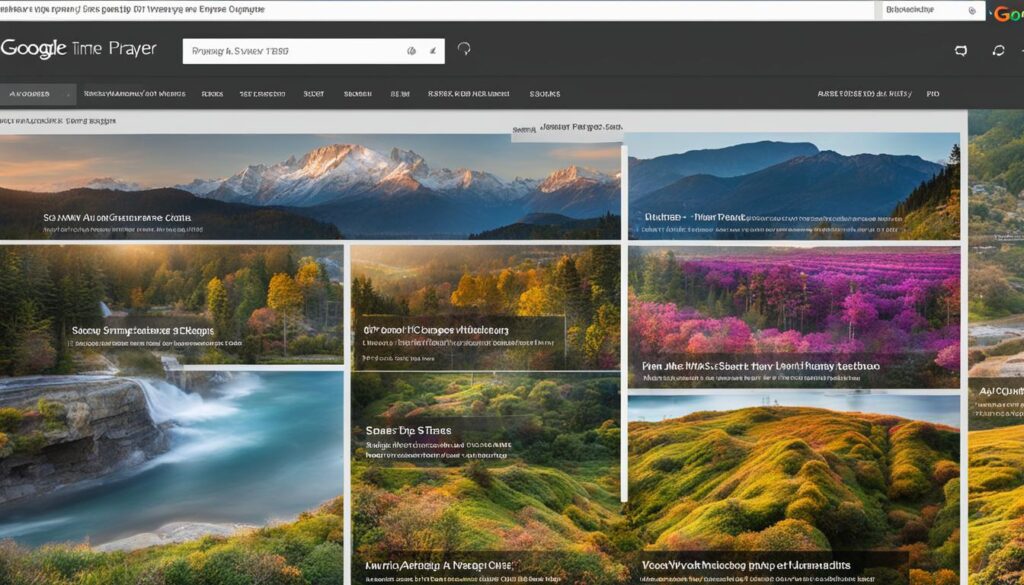As a practicing Muslim, it is essential to know the current prayer time and adhere to the prayer timetable. Prayer holds significant importance in Islam, and Muslims are required to pray five times a day at specific times. If you find yourself wondering, “What prayer time is it?” or need guidance on prayer procedures, this article will provide you with the necessary information.
Key Takeaways:
- Muslims pray five times a day at scheduled times
- Understanding the prayer process is crucial for correct performance
- Intention and concentration play a vital role in the effectiveness of prayer
- Cleanliness and using a prayer rug are essential elements for prayer
- Google’s prayer time snippets and their implementation can be beneficial
Understanding the Prayer Process
Learning how to pray correctly is essential for Muslims. The prayer process consists of specific steps and prayers that must be performed in a particular order. Here is a step-by-step guide to help you understand and learn how to pray:
- Takbir: Start by raising your hands to your ears and saying “Allahu Akbar” (Allah is the Greatest). This marks the beginning of the prayer.
- Recitation: Begin reciting verses from the Quran. The recitation can be in Arabic, or if you are not fluent, you can recite in your native language while working on learning the Arabic recitations.
- Bowing and Prostration: Perform the bowing position (Ruku) by bending at the waist and placing your hands on your knees. Then, move to the prostration position (Sujud) by placing your forehead, nose, hands, knees, and toes on the ground.
- Rak’as: Repeat these steps for each rak’a (cycle) of the prayer. The number of rak’as varies depending on the time of day and the type of prayer being performed.
- Tashahhud and Greetings: After completing the required number of rak’as, recite the final part of the Tashahhud, a supplication and praise to Allah. Then, turn your head to the right and say, “Assalamu alaikum wa rahmatullah” (Peace be upon you and the mercy of Allah). Finally, turn your head to the left and repeat the greeting.
It is important to note that this is a simplified guide to the prayer process. There are additional prayers, supplications, and movements that can vary depending on the specific prayer being performed. Consulting with a knowledgeable individual or referring to reputable sources can provide further guidance and understanding.
| Prayer Position | Description |
|---|---|
| Takbir | This marks the beginning of the prayer. Raise your hands to your ears and say “Allahu Akbar”. |
| Recitation | Begin reciting verses from the Quran. You can recite in Arabic or your native language. |
| Bowing (Ruku) | Bend at the waist, place your hands on your knees, and recite a supplication. |
| Prostration (Sujud) | Place your forehead, nose, hands, knees, and toes on the ground and recite supplications. |
| Tashahhud and Greetings | Recite the final part of the Tashahhud and greet to the right and left saying “Assalamu alaikum wa rahmatullah”. |
Importance of Intention and Concentration
Prayer is not just a series of physical movements and recitations; it is a deeply spiritual practice that requires sincerity and focus. The intention behind the prayer plays a significant role in its effectiveness. By making a heartfelt intention to perform the prayer with full attention and devotion, the worshipper can cultivate a deeper connection with the Divine.
Concentration during prayer is essential for experiencing its true benefits. It helps to quiet the mind, reduce distractions, and enhance the spiritual experience. By directing their focus solely on the prayer and blocking out external thoughts and concerns, individuals can connect more profoundly with their faith and cultivate mindfulness.
A sincere and focused prayer requires discipline and practice. It is important to create a calm and conducive environment for prayer, free from distractions. Finding a quiet space, turning off electronic devices, and focusing on the present moment can greatly enhance concentration during prayer. Engaging in self-reflection and adopting a humble and reverent attitude further aids in fostering a sincere and focused prayer experience.

Benefits of Intention and Concentration in Prayer
Intention and concentration in prayer have numerous benefits for individuals seeking a deeper connection with their faith. When prayer is performed with a sincere heart and focused mind, it allows individuals to:
- Establish a closer relationship with the Divine
- Experience inner peace and tranquility
- Develop mindfulness and spiritual awareness
- Find solace and guidance in times of difficulty
- Strengthen their faith and spiritual journey
By prioritizing intention and concentration in their prayer practice, individuals can unlock the transformative power of prayer and cultivate a deeper connection with their Creator.
Essential Elements for Prayer
When it comes to prayer, there are several essential elements that every Muslim should consider. These elements include the use of a prayer rug, maintaining cleanliness, performing ablution, and choosing an appropriate place for prayer. Let’s explore each of these elements in more detail.
A Prayer Rug for Added Comfort
While a prayer rug is not obligatory, many Muslims prefer to use one for added comfort and convenience during prayer. A prayer rug provides a designated space for prayer and can help create a sense of focus and tranquility. It also serves as a physical reminder of the importance of prayer in a Muslim’s daily life. The rug is typically placed on the ground, with the worshipper facing the Kaaba in Mecca.
Prayer Cleanliness and Ablution
Cleanliness is key when it comes to prayer. Before performing prayer, Muslims are required to perform ablution, also known as wudu. This involves washing specific parts of the body, such as the hands, face, and feet, to purify oneself before entering into a state of prayer. Ablution not only cleanses the body but also helps to prepare the mind and heart for a spiritual connection with the divine.
Choosing a Suitable Prayer Place
When it comes to praying, it is important to choose a clean and respectful place. This can be a designated prayer room in one’s home, a mosque, or any other quiet and secluded area. The chosen place should be free from distractions and conducive to prayer. Some individuals may find solace in praying outdoors, surrounded by nature, while others prefer the serenity of a mosque or a prayer room. The key is to select a location that allows for concentration and a sense of tranquility.
| Element | Description |
|---|---|
| Prayer Rug | A rug used for added comfort and a designated space for prayer. |
| Prayer Cleanliness and Ablution | The act of cleansing oneself before prayer. |
| Choosing a Suitable Prayer Place | Selecting a clean and respectful location for prayer. |
These essential elements – the prayer rug, cleanliness, ablution, and choosing a suitable place for prayer – contribute to a meaningful and focused prayer experience. By incorporating these elements into one’s prayer routine, individuals can enhance their spiritual connection and cultivate a deeper sense of devotion.
Commonly Asked Questions about Prayer
As prayer is an essential aspect of Muslim worship, it is natural to have questions about various aspects of this spiritual practice. Here, we address some of the most commonly asked questions to provide clarity and guidance.
Frequently Asked Question 1: Can I pray in my own language instead of Arabic?
Yes, you can pray in your own language while trying to learn and incorporate the Arabic recitations. While the Qur’an is exclusively in Arabic, it is acceptable to recite supplications or prayers in your native language, especially if you are in the early stages of learning Arabic. However, it is recommended to gradually learn the Arabic prayers to deepen your connection with the Qur’an and the Islamic tradition.
Frequently Asked Question 2: Can I pray alone or should I pray with others?
Both options are valid. While praying with other Muslims in congregation (known as Jama’ah) offers additional rewards and a sense of community, individual prayers (known as Salah al-Dhuha) hold their own significance. Praying with others can provide guidance for beginners and foster a sense of unity among worshippers. However, individual prayer allows for a more personal and intimate connection with Allah.
Frequently Asked Question 3: Do I need a specific prayer timetable?
Yes, it is important to follow the schedule for prayer times, regardless of your location. The timing of prayers varies depending on the position of the sun and geographical location. Islamic organizations and online platforms provide accurate prayer timetables based on reliable calculations and regional variations. Adhering to the prayer timetable ensures that you perform your prayers at the prescribed times.
By addressing these frequently asked questions, we hope to provide clarity and guidance on some common queries related to prayer. Remember, prayer is a deeply personal and spiritual journey, and the intention behind your prayers is of utmost importance. Embrace the journey of understanding and practicing prayer, and seek knowledge from reliable sources to enhance your worship.
Google’s Prayer Time Rich Snippets
Google has introduced a powerful feature called Prayer Time Rich Snippets that provides users with quick and convenient access to prayer timings directly in their search results. With this feature, individuals can easily find the accurate prayer times for their location without the need to visit specific websites or use separate apps.
Implementing Prayer Time Rich Snippets on your website can greatly enhance the user experience by providing an immediate answer to the prayer time queries of your visitors. By including the relevant structured data markup, such as location, calculation method, and prayer timings, you can ensure that your website appears prominently in the search results when users search for prayer times.
Website owners who wish to implement Prayer Time Rich Snippets can request whitelist access from Google. This access will allow their website to display the prayer timings directly in the search results, making it easier for users to access the information they need. To obtain whitelist access, website owners can contact Google and follow the guidelines provided by the search engine giant.
| Benefits of Google’s Prayer Time Rich Snippets | How to Implement Prayer Time Rich Snippets |
|---|---|
|
|
Example Implementation
“By implementing Google’s Prayer Time Rich Snippets, our website has become a go-to resource for Muslims looking for accurate prayer timings. The convenience of having the prayer times displayed directly in the search results has significantly improved the user experience, leading to increased traffic and engagement on our site. We highly recommend other website owners to take advantage of this feature to provide valuable prayer time information to their users.”

Implementing Google’s Prayer Time Rich Snippets is a valuable opportunity for website owners to enhance the user experience and provide accurate prayer time information. By following the guidelines provided by Google and including the necessary structured data markup, you can ensure that your website stands out in search results and becomes a trusted resource for individuals seeking prayer timings.
Implementing Prayer Times Rich Snippets
Implementing prayer time rich snippets on your website can provide valuable information to users who are looking for accurate and up-to-date prayer timings. By following the guidelines provided by Google, you can easily implement the necessary structured data markup to display prayer times on your website.
To start implementing prayer times rich snippets, you will need to include the location of your prayer area, the calculation method used for determining prayer times, and the actual prayer timings. This information will allow Google to generate the appropriate rich snippets in search results.
Here is an example of how the structured data markup for implementing prayer times rich snippets may look:
| Location | Calculation Method | Prayer Timings |
|---|---|---|
| New York City | Islamic Society of North America (ISNA) | 6:00 AM, 12:00 PM, 3:30 PM, 6:00 PM, 8:00 PM |
| Los Angeles | Muslim World League (MWL) | 5:30 AM, 11:30 AM, 2:00 PM, 4:30 PM, 7:00 PM |
By implementing prayer times rich snippets, you can enhance the accessibility of prayer time information on your website and provide a valuable service to your visitors.
Stories and Messages about Prayer
Prayer is a deeply personal experience for individuals of the Muslim faith, and it has the power to touch lives in profound ways. Through a myriad of stories and messages, leaders and individuals share their experiences and insights, offering inspiration and guidance for those seeking a deeper understanding of prayer.
These stories encompass instances of answered prayers, where individuals have witnessed the manifestation of their heartfelt requests. They serve as a reminder that prayer is not merely a ritual but a direct connection to the divine, capable of bringing about tangible outcomes in one’s life.
Alongside these stories, there are messages that highlight the importance of prayer in personal growth and spiritual development. Through consistent and sincere prayer, individuals find solace, strength, and guidance in navigating life’s challenges. Prayer becomes a source of comfort and a means to deepen their relationship with a higher power.
“Prayer has been an essential part of my life for as long as I can remember. It has provided me with a sense of peace and clarity in the midst of chaos. Through prayer, I have discovered courage and resilience, enabling me to overcome obstacles and face adversities with grace. It is through this daily practice that I have grown spiritually and found a deeper connection to my faith.” – [Name], Muslim Practitioner
Table: Prayer Stories and Messages
| Story/Message | Key Insight |
|---|---|
| Answered Prayers | Prayer has the power to bring about tangible outcomes in one’s life. |
| Personal Growth | Consistent and sincere prayer enables personal growth and spiritual development. |
| Strength in Adversity | Prayer provides solace, strength, and guidance in navigating life’s challenges. |
| Deepening Faith | Through prayer, individuals can forge a deeper connection with their faith. |
These stories and messages serve as a testament to the transformative power of prayer. They not only remind us of the importance of this sacred practice but also inspire us to approach prayer with sincerity, devotion, and an open heart. As we embark on our own prayer journeys, let us draw strength from these experiences and seek to deepen our connection with the divine.

Conclusion
In conclusion, prayer holds immense significance in the lives of Muslims. It is not only a way to connect with the Divine but also a means of seeking guidance, solace, and personal growth. By understanding the proper process and following the guidelines, individuals can perform their prayers correctly and effectively.
Moreover, intention and concentration play a pivotal role in the prayer experience. Approaching prayer with a sincere and focused mindset allows worshippers to deepen their spiritual connection and mindfulness. By avoiding distractions and striving for a heartfelt prayer, individuals can derive greater benefits from their worship.
Furthermore, the implementation of prayer time rich snippets on websites enhances accessibility to prayer information. This innovative solution by Google provides accurate and easily accessible prayer timings to users, allowing them to plan their prayers accordingly.
Overall, prayer is a fundamental pillar of Muslim faith, and it serves as a source of strength, guidance, and personal transformation. The stories and messages shared by leaders and individuals further emphasize the power and significance of prayer in one’s spiritual journey. Through prayer, believers find solace, inner peace, and a deeper connection with their Creator.
FAQ
Can I pray in my own language instead of Arabic?
Yes, you can pray in your own language while trying to learn and incorporate the Arabic recitations.
Can I pray alone or should I pray with others?
Both options are valid, but praying with other Muslims can provide guidance and a sense of community.
Do I need a specific prayer timetable?
Yes, it is important to follow the schedule for prayer times, which can vary based on your location.
How do I implement prayer times rich snippets on my website?
To implement prayer times rich snippets on your website, you need to follow specific guidelines provided by Google. This involves including the necessary structured data markup, such as location, calculation method, and prayer timings.
What are some stories and messages about prayer?
Leaders and individuals share their experiences and insights about prayer, including instances of answered prayers, the importance of prayer in personal growth, and the power of prayer in overcoming challenges.
What are the essential elements for prayer?
The essential elements for prayer include cleanliness of the body and the prayer area, the use of a prayer rug (optional), and performing ablutions if necessary.








